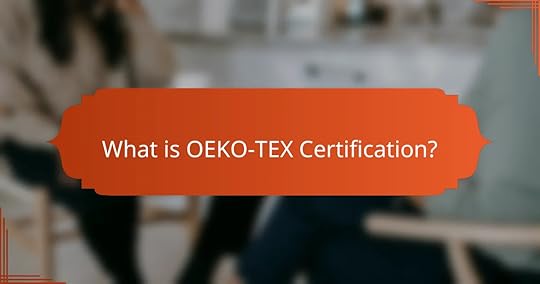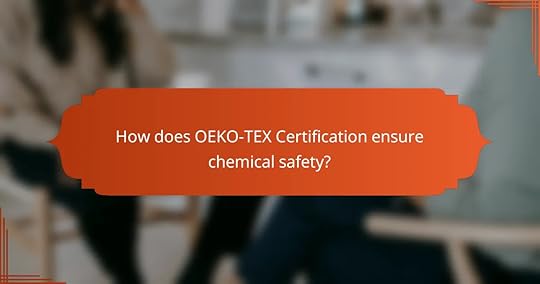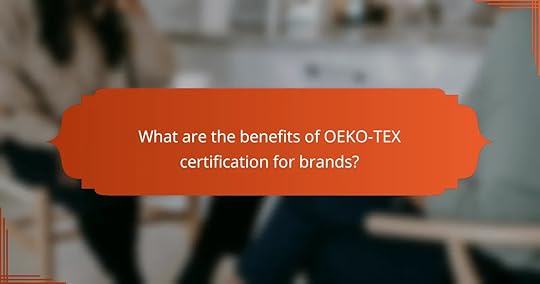OEKO-TEX Certification: Chemical Safety, Standards and Consumer Assurance
OEKO-TEX Certification is an internationally recognized standard that guarantees textiles and leather products are free from harmful chemicals. By rigorously testing for toxic substances, it provides consumers with confidence in the safety and sustainability of their purchases, promoting healthier choices in apparel and home textiles.

OEKO-TEX Certification is a globally recognized standard that ensures textiles and leather products are free from harmful substances. It provides consumers with assurance regarding the chemical safety of the products they purchase.
Definition of OEKO-TEX CertificationOEKO-TEX Certification encompasses several testing and certification systems for textiles, including the Standard 100 and Made in Green labels. These certifications evaluate products for harmful chemicals, ensuring they meet specific safety criteria set by the OEKO-TEX Association.
The certification process involves rigorous testing of raw materials, intermediate and end products, as well as the production processes. Products that pass these tests are labeled, allowing consumers to identify safe options easily.
Importance for consumersOEKO-TEX Certification is crucial for consumers seeking safe and environmentally friendly textile products. It helps them make informed choices, reducing the risk of exposure to harmful chemicals that can affect health and well-being.
By choosing OEKO-TEX certified products, consumers can trust that the items they buy, such as clothing and home textiles, have been tested for safety and adhere to strict environmental standards. This certification can also enhance brand loyalty, as consumers increasingly prioritize sustainability and safety in their purchasing decisions.

OEKO-TEX Certification ensures chemical safety by rigorously testing textiles for harmful substances and adhering to strict international standards. This certification provides consumers with assurance that products are free from toxic chemicals, promoting safer choices in apparel and home textiles.
Testing for harmful substancesOEKO-TEX conducts comprehensive testing for a wide range of harmful substances, including heavy metals, pesticides, and formaldehyde. Each product undergoes a thorough examination to ensure it meets safety criteria, which helps prevent health risks associated with chemical exposure.
Testing is performed in accredited laboratories and follows a standardized methodology. Products that pass these tests receive certification, indicating they are safe for human use, which is particularly important for items in direct contact with skin.
Compliance with international standardsOEKO-TEX Certification aligns with several well-known international standards, such as REACH in Europe and CPSIA in the United States. These regulations set limits on harmful substances, ensuring that certified products comply with global safety requirements.
By adhering to these standards, OEKO-TEX not only enhances consumer trust but also supports manufacturers in meeting legal obligations. This compliance helps brands differentiate themselves in the market, appealing to increasingly health-conscious consumers.

OEKO-TEX certification levels include various standards that assess textile products for harmful substances, ensuring safety and sustainability. The main certifications focus on different aspects of chemical safety, with each level providing specific assurances to consumers and manufacturers.
OEKO-TEX Standard 100OEKO-TEX Standard 100 is a globally recognized certification for textiles, ensuring that products are free from harmful substances. It applies to all stages of production, from raw materials to finished goods, and includes rigorous testing for over 100 harmful chemicals.
Products certified under this standard are categorized into four classes based on their intended use, such as baby products or items in direct skin contact. This classification helps consumers make informed choices based on safety levels appropriate for different age groups and sensitivities.
OEKO-TEX Made in GreenOEKO-TEX Made in Green certification indicates that a product is made from safe materials and produced in environmentally friendly facilities. This certification combines the principles of OEKO-TEX Standard 100 with additional criteria related to sustainable production practices.
To obtain this certification, manufacturers must provide transparency about their supply chain and production processes. This includes adherence to social responsibility standards, ensuring fair working conditions and environmental protection, which appeals to consumers seeking ethically produced goods.

Consumers can identify OEKO-TEX certified products by looking for specific labels on packaging or product listings. These labels indicate that the items meet stringent chemical safety standards, ensuring they are free from harmful substances.
Labeling on product packagingOEKO-TEX certified products typically display a label on their packaging, such as the OEKO-TEX Standard 100 label. This label often includes a unique certification number that consumers can verify online to confirm the product’s compliance with safety standards.
When shopping, look for labels that mention “OEKO-TEX” alongside terms like “tested for harmful substances.” This indicates that the product has undergone rigorous testing for potentially harmful chemicals.
Online product listingsMany online retailers provide information about OEKO-TEX certification in their product descriptions. Check for mentions of OEKO-TEX certification in the product details, which may include the specific standard it meets, such as Standard 100 or Made in Green.
Additionally, reputable brands often include links to their OEKO-TEX certification on their websites, allowing consumers to verify the authenticity of the certification. Always ensure the product listing is from a trusted source to avoid misleading claims.

OEKO-TEX certification offers brands significant advantages, including improved product appeal and assurance of chemical safety. By adhering to these standards, brands can differentiate themselves in a competitive market while ensuring consumer safety and compliance with regulations.
Enhanced marketabilityBrands with OEKO-TEX certification can effectively market their products as safe and environmentally friendly. This certification serves as a valuable selling point, especially in markets where consumers are increasingly concerned about sustainability and chemical exposure.
For example, textiles labeled with OEKO-TEX can attract eco-conscious consumers, potentially leading to higher sales. Brands can leverage this certification in advertising campaigns, emphasizing their commitment to quality and safety.
Consumer trust and loyaltyOEKO-TEX certification fosters consumer trust by ensuring that products are free from harmful substances. When customers see this certification, they are more likely to feel confident in their purchase decisions, knowing that the brand prioritizes their health and safety.
Building loyalty is easier for brands that consistently offer OEKO-TEX certified products. Repeat customers may be willing to pay a premium for products that guarantee safety and sustainability, enhancing long-term brand loyalty and customer relationships.

OEKO-TEX certification significantly influences e-commerce by assuring consumers of product safety and sustainability. This certification helps online retailers build trust and credibility, ultimately leading to increased customer loyalty and sales.
Increased sales potentialProducts with OEKO-TEX certification often experience higher sales potential due to growing consumer demand for safe and eco-friendly items. Shoppers are increasingly willing to pay a premium for certified goods, which can lead to improved profit margins for e-commerce businesses.
For instance, brands that highlight their OEKO-TEX certification in product descriptions and marketing materials can attract a broader audience. This can be particularly effective in markets like the European Union, where sustainability is a key purchasing factor.
Competitive differentiationOEKO-TEX certification serves as a powerful tool for competitive differentiation in the crowded e-commerce landscape. By showcasing compliance with rigorous safety standards, brands can set themselves apart from competitors who may not prioritize chemical safety.
Retailers can leverage this certification in their branding strategies, emphasizing their commitment to consumer health and environmental responsibility. This approach not only enhances brand image but also fosters customer loyalty, as consumers increasingly prefer brands that align with their values.

To obtain OEKO-TEX certification, products must meet specific criteria related to chemical safety and quality management. This involves compliance with chemical regulations and the implementation of robust quality management systems.
Compliance with chemical regulationsCompliance with chemical regulations is crucial for OEKO-TEX certification. Products must adhere to various international and national standards regarding harmful substances, including the REACH regulation in Europe and other relevant guidelines. This ensures that textiles are free from harmful chemicals that could pose risks to human health and the environment.
Manufacturers should conduct thorough assessments of their materials and processes to confirm compliance. Regular testing and documentation are essential to demonstrate adherence to these regulations, which may vary by region. For example, certain chemicals may be restricted in the EU but allowed in other markets.
Quality management systemsImplementing a quality management system (QMS) is another prerequisite for OEKO-TEX certification. A QMS helps organizations systematically manage their processes and ensure consistent product quality. This includes establishing protocols for monitoring and controlling production processes to minimize defects and ensure compliance with OEKO-TEX standards.
Companies should consider adopting internationally recognized standards, such as ISO 9001, to enhance their QMS. Regular audits and reviews of the system can help identify areas for improvement and maintain certification. A well-structured QMS not only supports OEKO-TEX certification but also boosts overall operational efficiency.

Emerging trends in OEKO-TEX certification focus on increasing consumer demand for sustainable and safe textile products. As awareness of environmental and health issues grows, brands are adapting their practices to meet these expectations through enhanced certification processes.
Focus on sustainabilitySustainability is becoming a cornerstone of OEKO-TEX certification, with brands prioritizing eco-friendly materials and production methods. This trend includes the use of organic fibers, recycled materials, and reduced water and energy consumption during manufacturing.
Companies are increasingly adopting the OEKO-TEX Standard 100 and the OEKO-TEX Made in Green label, which not only ensure chemical safety but also verify sustainable production practices. This dual focus helps brands appeal to environmentally conscious consumers.
To align with sustainability trends, brands should consider conducting regular audits of their supply chains and materials. Implementing transparent reporting practices can enhance consumer trust and demonstrate commitment to environmental responsibility.



